Angela Kalkbrenner is helping older Minnesotans create a routine to stay active and healthy in a safe, relaxing and enjoyable way — walking! As director of wellness at SilverCreek on Main, a senior living community in Maple Grove, MN, she is one of the people leading people through the Walk with Ease program to make walking part of their everyday life.

Offered through Juniper, this class increases balance, strength and walking pace. It also builds confidence around being physically active, while reducing pain and discomfort from arthritis and other health conditions. Angela says, “If you can walk for 10-15 minutes, you can take this class.” Walk with Ease classes are available in person and online.
Walk with Ease was designed by the National Arthritis Foundation to support people struggling with mobility and pain in their joints. According to the Foundation, walking helps reduce the pain, stiffness and inflammation from arthritis. Walking for 30 to 60 minutes every day can bring you all sorts of health benefits, from keeping your heart in good shape to making sure your bones stay strong.
 The Walk with Ease program brings structure to walking, and people are benefiting from it physically, but also emotionally because of the social connections made through walking with others.
The Walk with Ease program brings structure to walking, and people are benefiting from it physically, but also emotionally because of the social connections made through walking with others.
What is your starting point and what is your walking goal? With the help of our class leaders, you will have the opportunity to track your exercise and set goals for maximum benefit. And, you will learn how to walk safely and effectively.
Angela and her colleague, Aaron Erickson walk along with their SilverCreek group to coach them on posture, stride and other actions that help participants make the most of the activity. Angela shares these do’s and don’ts for safely walking with ease:
1. Stand straight and tall
Good posture is important, so stand tall, make sure your shoulders are over your hips and your chin is parallel to the ground.
2. Look ten feet out in front of you
Reaction time slows with aging, so you are more likely to see upcoming hazards sooner, allowing time for you to react and prevent tripping.
3. Plant your feet with a heal-toe landing or “strike”
People with arthritis tend to take shorter strides when walking, so they don’t get a good heal strike and roll to the toe. The important thing is that you choose a comfortable stride length.
4. Swing your arms a stride length
This helps with blood flow, energy conservation and balance.
5. If you use a walker, keep it close
Placing the walker too far out in front causes you to bend over and be less steady on your feet.
What are participants in the SilverCreek’s Walk with Ease program saying?
“I had my knee replaced in April,” says Jan Roadfeldt. “This program is getting me to walk on my own, walk straighter and without assistance. I’m walking like crazy!” Jackie Angus has visual challenges, making it difficult to walk on her own. “It’s difficult for me to see curbs and changes in ground levels,” she says. “I like walking with my group because my classmates warn me of what is head and give me an arm assist when needed.”
Angela says it makes her happy to help people feel more independent and safer with their walking. “If you can walk, you can do just about anything. And, my students are finding that they actually walk further than they thought they would. They are also building stronger muscles and bones because weight-bearing activity provides bone density and helps fight osteoporosis.”
Juniper encourages you to use Angela’s guidance to walk safely outside this fall and indoors as the weather changes. Learn more about the Walk with Ease classes offered in-person and online through Juniper. Find a class near you.